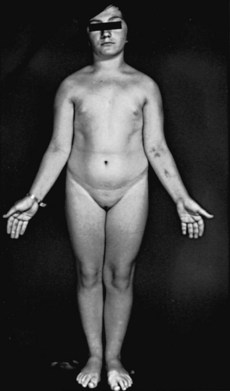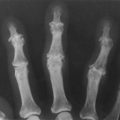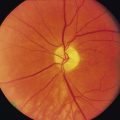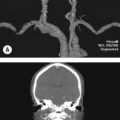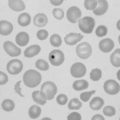233 Turner syndrome
Salient features
Examination
• Webbing of the neck in a female patient
• Abnormal angulation of both elbows: increased carrying angle (cubitus valgus; Fig. 233.1)
• Epicanthal folds, double eyelashes, strabismus occurs in 18%, and ptosis in 13%
• Low hairline over the back of the neck
• Shield-shaped chest: nipples are widely separated with microthelia
• Lymphoedema of the hands and feet
• Check for radiofemoral delay (coarctation of the aorta) and aortic stenosis.
• Tell the examiner that you would like to:
Advanced-level questions
Which other cardiovascular lesions are associated with webbing of the neck?
Noonan syndrome or Ullrich syndrome with pulmonary stenosis.
Is there a correlation between karyotype and phenotype?
Growth failure
• Loss of interstitial or terminal long-arm material of the X chromosome (Xq) can result in short stature and primary or secondary ovarian failure.
• Deletions distal to Xq21 appear to have no effect on stature.
• Loss of the short arm (Xp) results in the full phenotype.
• Very distal Xp deletions are compatible with, but do not ensure, normal ovarian function. Loss of this region usually confers short stature and the typical skeletal changes, in part as a result of haploinsufficiency of the short stature–homeobox (SHOX) gene, located in the pseudoautosomal region of Y and Xp. (SHOX is probably not the only gene that determines skeletal features.)
• Aneuploidy itself may contribute to growth failure.
• Women with mosaicism for 45,X/46,XX are marginally taller than other women with Turner syndrome.
What do you know about Lyon’s hypothesis?
Henry H Turner (1892–1970), an American endocrinologist, described this condition in 1938.
Mary Lyon (b. 1925), geneticist who worked for the Medical Research Council in Oxford.
There are several support groups for patients with Turner syndrome and their families.
Turner Syndrome Society of UK is such a support group; 12 Irving Quadrant, Hardgate, Clydebank G81 6AZ, UK; telephone +44(0)1389–380385; fax +44(0)1389–380384; e-mail Turner.Syndrome@tss.org.uk; or see www.tss.org.uk/contact.html. It provides:

